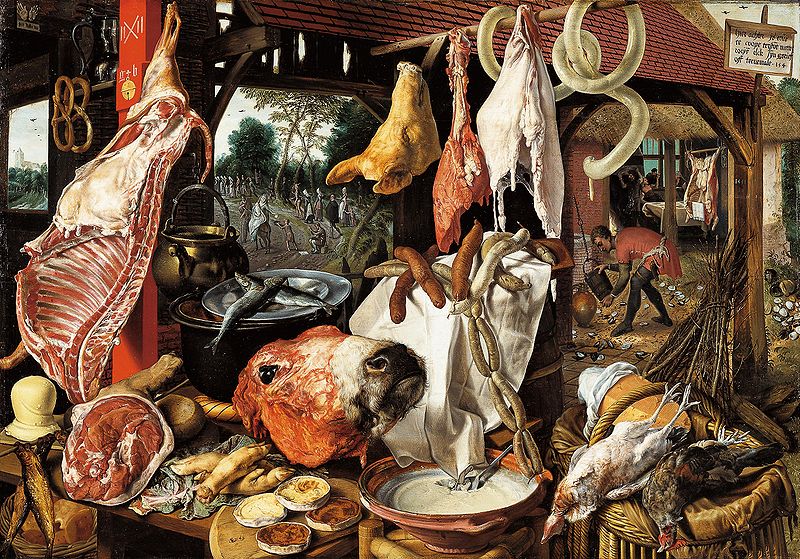| Still life by Sandy Quang. About 18X24, oil on canvas. |
| Sandy’s first draft, juxtaposing the Golliwog and bust of Pericles, was a good idea but a bad composition, so she jettisoned it. |

Watch Me Paint: World-Class Art, World-Class Instruction
| Still life by Sandy Quang. About 18X24, oil on canvas. |
| Sandy’s first draft, juxtaposing the Golliwog and bust of Pericles, was a good idea but a bad composition, so she jettisoned it. |
 |
| Butcher’s Stall with the Flight into Egypt, 1551,Pieter Aertsen |
 |
| Flowers in a Silver Vase, 1663, by Willem van Aelst, includes a pocketwatch (time), poppies (death), roses (Christian faith), tulips (folly), dragonfly (transience), and butterfly (resurrection). |
 |
|
Watermelon & Cherries, by Brad Marshall, oil on canvas board, 11×14. Executing this luscious painting probably elevated Brad’s mood by 22%, but who can tell when he’s already so darn cheerful? It’s for Rye Art Center’s annual Painters on Location in September, and I imagine it will elevate the mood of some lucky collector too.
|
 |
|
Wayne Thiebaud, Four cupcakes, 1971. Oil on canvas, 27,9 x 48,3 cm. Is Thiebaud a very happy man? He certainly should be; he painted enough cakes.
|
| Peppers, 6X8, oil on canvasboard, by little ol’ me. They made me more than 1% happier to paint, I swear. |
I know one thing that’s going to make me very happy: my July workshop in mid-coast Maine. Nothing is happier-making than painting with great friends in a brilliant place. There’s one more residential slot left in July; I’m dying to know who is going to fill it. August and September are sold out , but there are openings in October! Check here for more information.
Kim Jong-Il Looking at Things is my current favorite blog. I suppose it amuses me because it reduces a frightening, insane tyrant to an object of ridicule. (I sure hope he doesn’t see it and melt half of
Much of the time, he’s wearing a grey-and-lavender parka similar to one my dad used to wear. I assume they have no heat in
It dawned on me that in his parka he looks just like the opossum who was camping out in our basement, so that’s how I painted him. Used Abi’s “pet” opossum because the live one has been relocated to public housing elsewhere in the county.
A note about these still lives: they’re exercises before my “real work”, a sort of a meme-inside-a-meme, considering how popular the painting-a-day movement is. They take an hour, more or less. And I do them because I find the classic still life boring to paint, but it’s too cold for me outside to paint plein air.
I figure by the time spring comes, water reflections will seem awfully simple in comparison to all this plastic wrap, tinfoil and bubble wrap.
An ellipse is a plane curve with two foci which is symmetrical on both the vertical and positive axes, and intersects with these axes perpendicularly.
I recently heard a student tell another one, “She means not a racetrack and not a football.” Works for me, as long as it’s symmetrical both ways, as below.
Use that boring old method, a pencil held up in space, to measure the distances above the bowl’s ellipse and below it. You’ll be surprised at how often the bowl has very little showing below the rim, and a lot above the rim.
There is nothing like a contour drawing to check your composition. This is not time consuming, but the most important work you can do. The mantra of my studio is, “draw slow, paint fast” (and thank you to Rhea Horowitz for coining that). It’s a lot easier to correct mistakes in a pencil drawing than in a mush of paint.